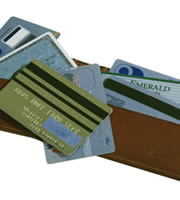Credit card rates go their own way

December 15, 2014
Current averages:
- Average consumer credit card rate, overall market: 17.17 percent
- Average consumer non-rewards credit card rate: 15.56 percent
- Average consumer rewards credit card rate: 17.87 percent
- Average student credit card rate: 17.56 percent
- Average business non-rewards credit card rate: 14.89 percent
- Average business rewards credit card rate: 15.62 percent
The U.S. bank prime rate is still 3.25 percent.
In an environment in which inflation has all but disappeared and mortgage rates have dipped back below 4 percent, one might reasonably expect credit card rates to be falling as well. Yet for the third time in the last four of these semi-monthly surveys, there has been an increase in credit card rates, this time in the business rewards category.
So far this year, every category of credit cards tracked by this survey has seen its average rate increase, but rates for the rewards categories — both consumer and business — have risen by more than for non-rewards categories. That could be a sign that consumers have gotten more efficient about redeeming their rewards, and so credit card companies are responding by increasing rates to cover the extra cost of those programs.
This dynamic in the rewards categories may explain some of the rise in credit card rates this year, but to varying extents rates are up in all categories, so the cost of rewards programs cannot be the entire reason rates have risen. What is striking about the overall trend towards higher credit card rates is that it comes at a time when inflation is especially mild. Normally, lower inflation would create room for credit card rates to fall. According to the Bureau of Labor Statistics, inflation for the past 12 months was just 1.7 percent, thanks largely to year-over-year decreases in gasoline and fuel oil prices.
While it seems odd that credit card rates should be rising in the face of this disinflation trend, it should be noted that not all credit card companies have raised their rates. This is a reminder that each credit card will have a different reaction to market conditions, and so alert consumers should keep an eye on both the rates they are paying and the rates otherwise available, to make sure they are making the best of any given interest rate environment.
Consumer credit cards
Consumer credit card rates remained unchanged in the latest survey. As is the case with business credit cards, consumer rewards credit cards have seen their rates rise more sharply this year than non-rewards cards. For consumers who regularly pay interest on a credit card balance, the widening gap between rewards and non-rewards credit card rates should be a cue to evaluate whether they are getting enough economic value out of the rewards to justify the extra interest expense.
Student credit cards
Student credit card rates were unchanged in the latest survey.
Business credit cards
The average business rewards credit card rate rose by 9 basis points in the latest survey to 15.62 percent. In total, business rewards credit card rates have risen by 31 basis points so far in 2014, more than any other category.
The greater increase in business rewards credit card rates widens the gap between rewards and non-rewards rates. For businesses with prompt payment procedures that can avoid incurring any interest on their credit cards, this widening gap is not particularly significant. However, for businesses that do pay interest on their credit cards, that widening gap should prompt a cost/benefit analysis to see whether the company is getting its money’s worth out of the extra cost of the rewards program.
Excellent credit vs. average credit
With no change in consumer credit card rates, the difference between the average rate for customers with excellent credit and the overall average remained unchanged at 4.06 percent.
In total, IndexCreditCards.com surveys information from nearly 50 different credit cards, and includes multiple credit-rating tiers from many of those cards. Examples of offers surveyed include American Express, Capital One, Chase, Citi, Discover, and other MasterCard and Visa branded cards. The information compiled not only demonstrates trends in credit card rates over time, but also indicates the different values credit card companies put on different target markets (consumer, business, etc.), as evidenced by the differences between rates for those markets.
Disclaimer:The information in this article is believed to be accurate as of the date it was written. Please keep in mind that credit card offers change frequently. Therefore, we cannot guarantee the accuracy of the information in this article. Reasonable efforts are made to maintain accurate information. See the online credit card application for full terms and conditions on offers and rewards. Please verify all terms and conditions of any credit card prior to applying.
This content is not provided by any company mentioned in this article. Any opinions, analyses, reviews or recommendations expressed here are those of the author’s alone, and have not been reviewed, approved or otherwise endorsed by any such company. CardRatings.com does not review every company or every offer available on the market.
Published